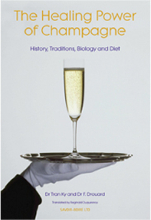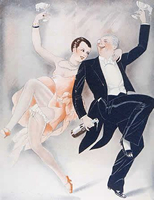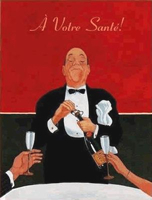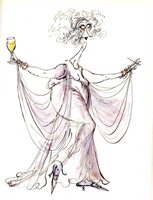It's
a book about Mythology, History, Biology, Biochemistry,
Wine Making & Viticulture and above all, it is a Treatise
on Champagne therapy as an alternative, when taken fluteful
a day. The book written by Drs. Tran Ky and Francois Drouard
is an effervescent tribute to champagne, says Subhash
Arora who reviews the book translated into English
by Reginald Duquesnoy and published by Savoir-Boire Ltd.
 Doctors
may take this book with a pinch of salt (or a glass of champagne)
for the book commends Champagne for its medicinal value
to cure various common maladies. Like any other alternative
medicines, if you put your complete faith in these two champagne
smitten doctor- authors, champagne will cure you of many
medical problems. Doctors
may take this book with a pinch of salt (or a glass of champagne)
for the book commends Champagne for its medicinal value
to cure various common maladies. Like any other alternative
medicines, if you put your complete faith in these two champagne
smitten doctor- authors, champagne will cure you of many
medical problems.
The book is a smooth and effervescent
read with a lot of humour thrown in. But for being a bit
gross here and there ( are they being French?) it is a light
reading, taking one through the history and various wine
loving personalities with quotes sprinkled here and there
along with some beautiful lithographs adorning the text.
Though it recommends only
a flute a day, it seduces you to finish reading it all in
one sitting, like the whole bottle in one evening- just
like I felt compelled to.
It has dedicated individual
chapters on Stimulation of Desire, Obesity, Loss of Appetite,
Arterial clogging, migraine headaches, insomnia, drugs,
gynaecological troubles, gerontology and ageing, food allergies,
constipation, indigestions and more, giving you tips on
how Champagne helps you to get rid of your physical misery
The generous use of Moet Chandon
bottles in the photographs leaves an impression that it
was sponsored by the monolithic giant and the market leader,
if it weren't for the last page of the medical section of
the book which shows the picture of a Pol Rogers bottle
and Winston Churchill's back with his famous quote, 'Remember,
gentlemen, we are not just fighting for France, we are fighting
for champagne'.
 A
third of the 156 page book in hard-cover has been allocated
to Documentary Annexes like the grape variety, vine and
mushrooms, the magic of yeast and some organoleptic considerations. A
third of the 156 page book in hard-cover has been allocated
to Documentary Annexes like the grape variety, vine and
mushrooms, the magic of yeast and some organoleptic considerations.
The section talks of some
commonly known facts like the vine needing three years to
start giving fruit and ten years to reach full capacity
or that Chardonnay grown in Chablis and Champagne is three
quarters of the total quantity produced in France.
These are supplemented by
lesser known facts like Pinot Meunier being so important
component in the ideal French ménage-a-trois that
it is a global object of intensive study, especially in
California where the Oenological Institute nurtures the
dream of producing a great 'champagne' one day.
The language used is very
floral, with earthy notes. Did you know that 'The vine plant
has to co-exist symbiotically with invisible mushrooms which
take up the nutritive elements like phosphorous and mineral
elements like zinc, copper and magnesium, in the soil and
pass them to the vine?' These hard working mushrooms are
also far-sighted, say the authors. They build a permanent
reserve of these important minerals in their cells. In case
of drought or deficiency, it is they who feed the vines
with their stores.
The gist of the whole book
is that one flute a day is cure for most of the ailments
mentioned above; and more is not advisable. It compares
this 'medicine' with homeopathic medicines which are therapeutic
for a wonderful cure when taken in small doses but can be
very harmful if taken in stronger doses.
The book is highly recommended
for doctors and patients who also believe in alternate medicine,
wine producers and connoisseurs alike. The Technical part
is reserved for winemakers, viticulturists and serious students
of wine.
 By
the end of the book, you may switch from wine to this bubbly
nectar for medical reasons. And you may want to shift your
existing Champagne bottles from the wine cellar to the medicine
cabinet. By
the end of the book, you may switch from wine to this bubbly
nectar for medical reasons. And you may want to shift your
existing Champagne bottles from the wine cellar to the medicine
cabinet.
Do make sure it has a storage
temperature of 13-16° C.
The book should be a fabulous
gift idea for Moet& Chandon to promote their wine, though
Pol Roger might be delighted to gift it to the corporate
honchos and important customers too. It may be ordered from
the publishers in UK directly at £25+shipping by visiting
their website www.savoirboire.co.uk.
A Votre Santé. To Your
Health.
Subhash Arora
The Review is a follow up
on our earlier Article; 'Champagne might Protect Brain Cells
from Injury' at http://www.indianwineacademy.com
A significant number of Indians
refrain from drinking Champagne claiming it gives them headache.
Many of these are not even allergic to Sulphur , which is
a cause of headache for such people. I posed this question
to Reggie Duquesnoy for his opinion. His reaction was, 'perhaps
these people are drinking sparkling wines and not Champagne,
the production of which is severely regulated and controlled.'
 'There
are some pretty decent sparkling wines made in other regions
of France, or Spain and Italy but none can aspire to the
quality of champagne ( which is not to say that all champagnes
are good and well made, some craft their product better
than others),'he added. 'There
are some pretty decent sparkling wines made in other regions
of France, or Spain and Italy but none can aspire to the
quality of champagne ( which is not to say that all champagnes
are good and well made, some craft their product better
than others),'he added.
'Many of the latter add
sufites to their product to stabilize it and
prevent it from becoming vinegar.'
Even champagne can provoke
headaches, he concedes. 'if you drink too much. But then
it is the excess alcohol, not the champagne which is the
trigger. If you read the book from the narrower therapeutic
angle, you will have seen that our leitmotif is a glass
per meal. That is the medicinal dose. For the more traditional
convivial practice, 2 glasses per woman, 4 for a man have
to be considered as the asymptotic limit... and not everyday
of course.'
I am not sure if the reply
answers my question satisfactorily, but generally speaking
if you follow the advice of drinking in moderation good
quality champagne, you should remain safe, sound and healthy,
as he also recommends. |